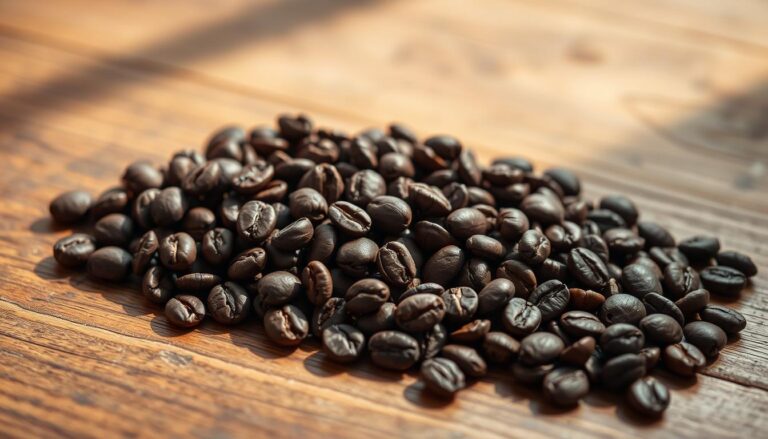Have you ever wondered which coffee is stronger? Turkish coffee or Italian espresso? Coffee fans worldwide argue about what makes a coffee strong.
Looking into coffee strength, we find that caffeine and taste are key. Turkish coffee and espresso are two unique ways to enjoy coffee. Each has its own special qualities that challenge our idea of strong coffee.
To understand the difference between Turkish coffee and espresso, we need to look at their brewing methods, caffeine levels, and cultural importance. The way coffee is made, the beans used, and the rituals involved all shape these distinct coffee experiences.
Key Takeaways
- Turkish coffee and espresso offer different strength experiences
- Caffeine content varies between these two brewing methods
- Brewing time and technique significantly impact coffee strength
- Cultural traditions play a role in coffee preparation
- Personal preference determines the ultimate coffee experience
Turkish Coffee and Espresso
Coffee fans worldwide love different ways to make coffee. Turkish coffee and espresso are two standout methods. They show how coffee can be made differently, with unique beans and cultural meanings.

Turkish Coffee
Turkish coffee comes from the Middle East. It uses very fine Turkish coffee beans, almost like powder. The process includes:
- Using a special pot called cezve
- Brewing with water and optional sugar
- Cooking over low heat for 5-10 minutes
- Serving with grounds settled at the cup’s bottom
Exploring Espresso
Espresso is an Italian coffee innovation. It’s made differently than Turkish coffee, with a mix of Arabica and Robusta beans. Key features are:
- High-pressure extraction (10-15 bars)
- Brewing time of 25-30 seconds
- Producing a small, intense shot
- Creating a distinctive crema on top
Brewing Method Differences
The main differences are in grind size and brewing techniques. Turkish coffee needs a very fine grind, while espresso uses a bit coarser. Also, Turkish coffee is unfiltered, and espresso needs a special machine.
Over 400 billion cups of coffee are consumed worldwide annually, highlighting the global passion for diverse brewing methods.
Comparing Strength: Caffeine Content
Understanding the caffeine in coffee can help you choose better. Turkish coffee and espresso have different caffeine levels. Their strengths are interesting to compare.

Caffeine Levels in Turkish Coffee
Turkish coffee is special in how it’s made. It has about 50-65 milligrams of caffeine in a 2-ounce cup. The method includes:
- Extremely fine ground coffee
- Slow brewing process (5-10 minutes)
- Unfiltered coffee preparation
Caffeine Levels in Espresso
Espresso has more caffeine than Turkish coffee. A single shot has about 63 milligrams. A double shot has up to 130 milligrams. Its key features are:
- Quick extraction (25-30 seconds)
- High-pressure brewing method
- Concentrated caffeine per ounce
Factors Affecting Caffeine Strength
Many things affect caffeine levels. Caffeine content depends on:
- Coffee bean type
- Roast level
- Grind size
- Brewing duration
Pro tip: The FDA says to limit caffeine to 400 mg daily. That’s about 6-8 cups of Turkish coffee.
“Coffee is a way of stealing time that should by rights belong to your older self.” – Terry Pratchett
Taste and Flavor Profile Differences
Turkish coffee and espresso offer unique tastes that excite coffee lovers everywhere. Each method highlights different qualities in the same coffee beans. This makes them into two very different drinks.
Flavor Characteristics of Turkish Coffee
Turkish coffee is known for its rich, full taste. Its traditional way of making it creates a strong flavor. It uses Arabica beans, giving it a smooth feel and deep flavors.
- Extremely fine ground consistency
- Slow brewing process
- Robust and unfiltered taste
- Thick, almost syrup-like texture
Flavor Characteristics of Espresso
Espresso is a concentrated coffee with a creamy top. It’s made with Arabica and Robusta beans. This mix gives it a bold taste that many enjoy.
How Preparation Influences Taste
The way coffee is made greatly affects its taste. Turkish coffee’s slow simmer lets flavors grow slowly. Espresso’s quick brewing makes a sharp, intense taste. Your choice depends on whether you like a slow brewing ritual or a quick caffeine boost.
“Coffee is a language in itself.” – Jackie Chan
Knowing these differences helps you value the skill in each brewing method. It lets you pick the coffee that suits your taste best.
Cultural Context of Coffee Consumption
Coffee is more than a drink; it’s a cultural experience that brings people together. It shows us how different cultures interact and their historical practices. Exploring coffee culture in various regions offers a glimpse into social norms and traditions.
Origins of Turkish Coffee
The Turkish coffee tradition began in Yemen in the mid-15th century. It spread to the Ottoman Empire and by the late 16th century, Istanbul had many coffee cafes. These cafes changed social gatherings. In 2013, UNESCO named Turkish coffee an Intangible Cultural Heritage, showing its deep cultural value.
- First coffee house in Istanbul opened in 1554
- Uses extremely fine ground beans
- Prepared in a traditional cezve or ibrik
History of Espresso in Italy
Italian espresso culture started in the late 19th century. Angelo Moriondo invented the first espresso machine in 1884. Later, Luigi Bezzera improved it, laying the groundwork for today’s espresso.
Italians made coffee a quick, social ritual. They enjoy it standing at cafe bars.
“Espresso is not just a drink, it’s a way of life in Italy.”
Coffee Drinking Etiquette in Different Cultures
Coffee etiquette varies greatly across cultures. In Turkey, coffee is an art form and a way to tell fortunes. In Italy, espresso is quick and social. Each culture has its own coffee traditions.
- Turkish coffee involves social storytelling
- Italian espresso is typically consumed quickly
- Each culture has distinctive coffee traditions
Conclusion: Which is Stronger?
When we talk about Turkish coffee vs espresso, it’s not just about caffeine. Your choice depends on more than just caffeine levels. An espresso shot has about 63 milligrams of caffeine in just one ounce. On the other hand, Turkish coffee has 50-65 milligrams in 2-3 ounces.
Each brewing method has its own special qualities. Espresso gives you a fast, strong flavor that’s great for a quick caffeine fix. Turkish coffee, on the other hand, is a more traditional experience. It’s made without filters and has a rich history, making each sip special.
So, it’s really up to you: do you like a quick espresso or a slow, traditional Turkish coffee? Both have their own flavors and meanings that go beyond caffeine.
Your coffee choice is all about what you enjoy. Whether it’s the strong espresso or the complex Turkish coffee, each has its own way of making coffee special.







